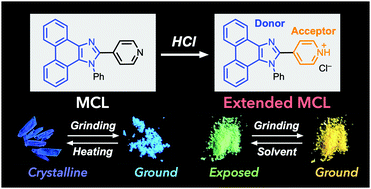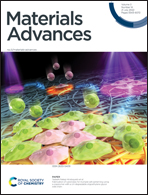Tunable mechanochromic luminescence via surface protonation of pyridyl-substituted imidazole crystals†
Abstract
Over the past decade, a growing number of luminescent organic materials exhibiting mechanochromic luminescence (MCL) have been developed, but controlling the magnitude of the mechanically induced shift in emission wavelength is still a great challenge. Herein, the rational extension of the MCL shift has been achieved via surface protonation of pyridyl-substituted imidazole crystals 1 and 2. The MCL shift of phenanthroimidazole 1 was 38 nm, whereas the emission wavelength of triphenylimidazole 2 was not affected by mechanical stimuli. After being treated with HCl vapor, the MCL shifts of 1 and 2 increased to 64 and 37 nm, respectively. In situ fluorescence microscopy has revealed that when exposed to HCl vapor, small microcrystals (1–4 μm in size) attached to the surface of a large crystal responded faster in terms of emission properties than the larger crystal. On the basis of powder X-ray diffraction analysis, spatially resolved fluorescence microscopy, and fluorescence lifetime analysis, the extended MCL shift after acid exposure should be achieved by mixing protonated molecules near the crystal surface with non-protonated molecules that remained in the interior of the crystal. The extension of the MCL shift via surface protonation of crystals serves as a new method for manipulating the MCL behavior of crystalline materials, which should accelerate the future development of MCL materials with rationally controlled properties.



 Please wait while we load your content...
Please wait while we load your content...